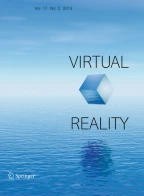Abstract
Virtual environments are increasingly used to support collaborative activities and distance learning. However, few are designed to support students, instructors and simulations in multi-participant team training. This paper describes the Training Studio, a system for authoring, delivering and evaluating multi-participant team training in an immersed virtual environment. The Training Studio focuses on human-systems interaction, allowing multiple students to learn and perform team tasks. The Training Studio supports collaborative learning for either single or multi-participant activity. This is accomplished through the use of agents which are assigned to students to act as personal mentors or missing team members. Conducting team training within a virtual environment introduces complexities and issues unique to team training and multiple-participant virtual environments. This paper describes our approach to virtual environment team training, discussing issues confronted and resulting design considerations and implementations.
Similar content being viewed by others
Explore related subjects
Discover the latest articles, news and stories from top researchers in related subjects.References
Grant F, McCarthy L, Pontecorvo M, Stiles R. Training in virtual environments. In: Proceedings of Conference on Intelligent Computer-Aided Training, NASA Johnson Space Center, Houston, Tex., 1991. http://technology.jsc.nasa.gov/success/icat.htm
Laird JE, Newell A, Rosenbloom PS. Soar: an architecture for general intelligence. Artificial Intelligence 1987; 33(1):1–64
Dewey J. Fundamentals of educational process. intelligence in the modern world: John Dewey's philosophy. Ratner J ed. Random House New York, 1939
Dillenbourg P, Baker M, Blaye A, O'Malley C. The evolution of research on collaborative learning. 1994. http://tecfa.unige.ch/tecfa-research/lhm/ESF-Chap5.text
Collins A, Seely Brown J, Newman S. Cognitive apprenticeship: teaching the crafts of reading, writing, and mathematics. In: Knowing, learning, and instruction: essays in honor of Robert Glaser. Resnick LB ed.: Lawrence Erlbaum Associates, Hillsdale, N.J., 1989
Berryman S. Designing effective learning environments: cognitive apprenticeship models. Institute on Education and the Economy, Bl-1, September 1991
Burns J, Salas E, Cannon-Bowers JA. Team training, mental models, and the team model trainer. In: Proceedings of Advancement in Integrated Delivery Technologies, Denver, Colo., 1993. http://www.ntsc.navy.mil/code4/496/bibliography/newtt_bib_1_decis.htm
Munro A, Johnson M, Surmon D, Wogulis J. Attribute-centered simulation authoring for instruction. In: Proceedings of the World Conference on Artificial Intelligence in Education, IOS Press. 1993; 82–89
Johnson WL, Rickel J, Stiles R, Munro A. Integrating pedagogical agents into virtual environments. Presence 1998; Presence: Teleoperators and Virtual Environments 7(6): 523–546, Dec 1998
Rickel J, Johnson WL. Animated agents for procedural training in virtual reality: perception, cognition, and motor control. Applied Artificial Intelligence 1999; 13:343–382
International Standards Organization, 1996. Virtual reality modeling language 2.0 specification, (ISO/IEC DIS14772-1:1997). http://www.web3d.org/fsspecifications.htm
Stiles R, Tewari S, Mehta M. Adapting VRML 2.0 for immersive use. In: Proceedings of the VRML '97 Second Symposium on the Virtual Reality Modeling Language, Monterey, Calif., 1997
Stiles R, Tewari S, Mehta M, McCarthy L. Adapting VRML for free-form immersed manipulation. Proceedings of the VRML '98 Third Symposium on the Virtual Reality Modeling Language, Monterey, Calif., ACM press. 1998
Cassell J, Pelachaud C, Badler N, Steedman M, Achorn B, Becket T, Douville B, Prevost S, Stone M. Animated conversation: rule-based generation of facial expression, gesture and spoken intonation for multiple conversational agents. In: Proceedings of ACM SIGGRAPH '94, 1994
Duncan S Jr, Fiske D. Face-to-face interaction: research, methods, and theory. Lawrence Erlbaum Associates, Hillsdale, N.J., 1977
Badler N, Phillips C, Webber B. Simulated agents and virtual humans. Oxford University Press, Oxford, 1993
Gibbs G, Skinner C, Teal A. CoMentor: A collaborative learning environment on the WWW for philosophy and social theory students. In: Proceedings of International Conference on Internet Research and Information for Social Scientists, Bristol, U.K., 1998
Mateas M, Lewis S. A MOO-based virtual training environment. Journal of Computer-Mediated Communication 1996; 2:3 [online]
André E, Rist T. Coping with temporal constraints in multimedia presentation planning. In: Proceedings of the Thirteenth National Conference on Artificial Intelligence (AAAI-96), AAAI Press, Menlo Park, Calif. and MIT Press, Cambridge, Mass., 1996; 142–147
André E, Mueller J, Rist T. Life-like presentation agents: a new perspective for computer-based technical documentation. In: Proceedings of the Al-ED Workshop on Pedagogical Agents, Kobe, Japan. Rickel J,. Lester J eds. 1997; 1–8
André E, Rist T, Mueller J. Webpersona: a lifelike presentation agent for the World-Wide Web. In: Proceedings of the IJCAI Workshop on Animated Interface Agents: Making Them Intelligent, Nagoya, Japan, 1997; 53–60
Billinghurst M, Savage J. Adding intelligence to the interface. In: Proceedings of the IEEE Virtual Reality Annual International Symposium (VRAIS '96), Los Alamitos, California. IEEE Computer Society Press, Los Alamitos, Calif., 1996; 168–175
Stone BA, Lester JC. Dynamically sequencing an animated pedagogical agent. In: Proceedings of the Thirteenth National Conference on Artificial Intelligence (AAAI-96), AAAI Press, Menlo Park, Calif. and MIT Press, Cambridge, Mass., 1996: 424–431
Lester JC, Voerman JL, Towns SG, Callaway CB. Cosmo: a life-like animated pedagogical agent with deictic believability. Proceedings of the IJCAI Work-shop on Animated Interface Agents: Making Them Intelligent, Nagoya, Japan, 1997; 61–69
Angros R, Rickel J, Johnson WL. Agents that learn to instruct. In: Proceedings of AAAI 1997 Fall Symposium Series: Intelligent Tutoring Systems Authoring Tools, FS-97-01. AAAI Press, New York, 1997
See also
Rickel J, Lester J eds. Proceedings of the Al-ED Workshop on Pedagogical Agents, Japan, 1997
Resnick M. Collaboration in simulated worlds: learning through and about collaboration. In: Proceedings of Spring ACM Conference on Computer-Supported Collaborative Learning, 1992
Schank R, Abelson R. Scripts, plans, goals and understanding. Lawrence Erlbaum Associates, Hillsdale, N.J., 1977
Author information
Authors and Affiliations
Corresponding author
Rights and permissions
About this article
Cite this article
McCarthy, L., Stiles, R., Johnson, W.L. et al. Human-systems interaction for virtual environment team training. Virtual Reality 4, 38–48 (1999). https://doi.org/10.1007/BF01434993
Issue Date:
DOI: https://doi.org/10.1007/BF01434993
